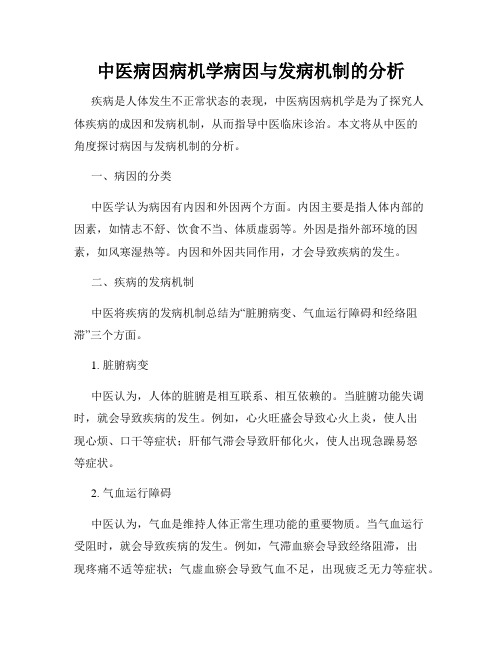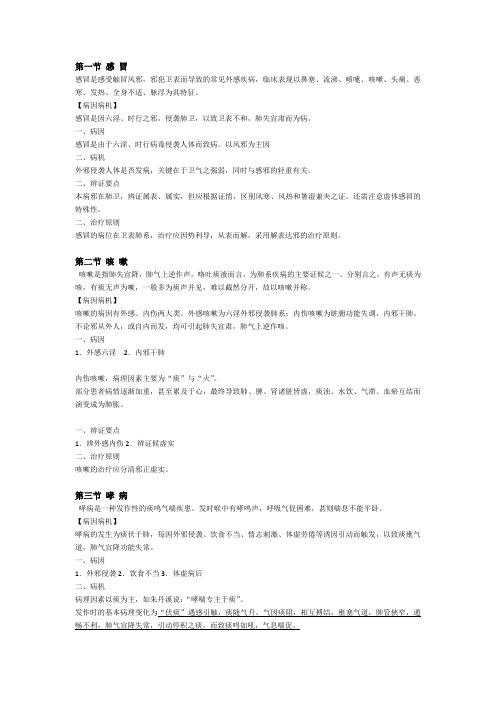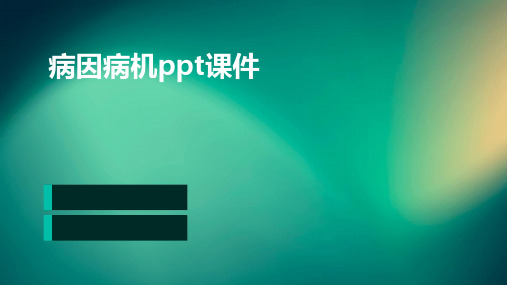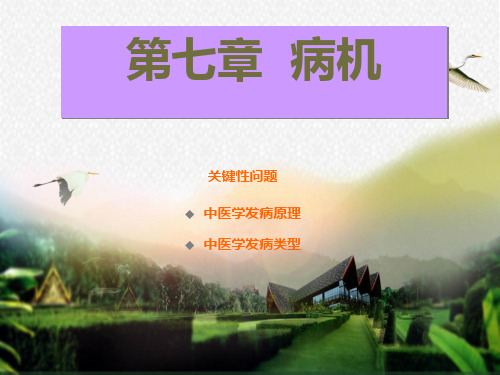发病病机
中医对低烧的发病原因病机的认识

低烧病因病机内伤发热主要由情志、饮食、劳倦等内伤原因致使脏腑气血阴阳失调而产生。
若由于脏腑气血阴阳偏虚而产生多称为虚热、虚火,为虚症。
若由于气机郁结,淤血停滞,饮食积滞,湿热阻滞等引起的发热则多为实症或虚实夹杂症,现分述如下:1.阴精亏虚:素体阴虚,或热病日久伤阴,或久泻,或过用误用温燥药物等,导致阴精亏虚,水不制火,阳气相对偏盛而引起发热。
正如《景岳全书。
火症》说:“阴虚者能发热,此以真阴亏损,水不制火也。
”2.中气不足:过度疲劳,加之饮食失调,或病后失于调养,、以致脾胃气虚发热。
关于气虚发热的具体病理机转各家说法不一,主要有一下一些不同看法,可供我们参考:一是认为脾胃气焰,中焦虚寒,因而使虚阳外越而成现象。
二是认为脾胃气虚,谷气下流而藴为湿热,促使下焦阴火上冲而致发热。
阴火是对阳火而言,阳火时元气的别名。
阴火泛指虚火、邪火。
气虚下陷,阴损及阳,虚火上乘,或脾虚藴生湿热之邪火上乘均可致发热。
三是认为气虚卫外不固,外感邪气,正邪相搏而发热。
正如《景岳全书。
火症》说:“气本属阳,阳气不足,则寒从中生,寒从中生则阳无所依而浮散于外,是即虚火假热之谓也。
”《脾胃论。
饮食劳倦所伤为热中论》说:“脾胃气虚,则下流于肾,阴火得以乘其士位”,“无阳以护其荣卫,则不任风寒,乃乘寒热”。
3.肾阳虚弱:平素阳气不足,或寒症日久伤阳,或误用过用寒凉药,导致肾阳虚弱,寒气内盛,格阳于外,虚阳浮于外而发热。
正如《景岳全书。
火症》所说:“阳虚者,亦能发热,此以元阳败竭,火不归原也。
”脾胃气虚日久,亦可导致脾肾阳虚,成为阳虚发热。
4.血虚失养;久病心肝血虚,或脾胃不能生血,或因出血,产后或手术后是学过多,以致系、血虚失于濡养。
血本属阴,阴血不足,无以敛阳,而导致阳浮发热。
正如《证治汇补。
发热》说:“血虚发热,一切吐衄便血,产后崩漏,血虚不能配阳,阳亢发热者,治宜养血。
”血虚发热多呈气血两虚或阴血两虚两现。
5.肝经郁热:情志抑郁,肝气不能条达,气郁化火而致发热,或因恼怒过度,肝火内盛以致发热。
中医基础理论第七、八章 病机习题集

第七、八章发病病机一、选择题(一)A1型题1.机体感受病邪,病邪潜伏一段时间之后发病者,属( )A.徐发B.继发C.复发D.伏而后发E.感而即发2.原病再度发作或反复发作,称为( )A.徐发B.继发C.复发D.伏而后发E.感而即发3.外感湿邪致病,其发病多为( )A.徐发B.继发C.复发D.伏而后发E.感而即发4.肝病胁痛、黄疸,若久治不愈,渐成“癥积”者,应属于( )A.徐发B.继发C.复发D.伏而后发E.感而即发5.外感六淫邪气致病,其发病多为( )A.徐发B.继发C.复发D.伏而后发E.感而即发6.血随气逆得病机就是因为( )A.气能行血B.气能摄血C.气能生血D.血能载气E.血能化气7.津伤化燥病机多见于( )A.心B.肺C.脾D.肝E.肾8.与内湿病理形成密切相关得脏就是( )A.心B.肺C.脾D.肝E.肾9.内寒病理得形成,除肾外,密切相关得脏还有( )A.心B.肺C.脾D.肝E.肾10.与风气内动形成密切相关得脏就是( )A.心B.肺C.脾D.肝E.肾11.血不足病变多见于( )A.心肺B.心脾C.心肾D.心肝E.肝肾12.与气不足病变形成密切相关得脏就是( )A.心脾肾B.肝脾肺C.心肺肾D.脾肾肺E.肺肝肾13.与气陷病变密切相关得脏就是( )A.心B.肺C.脾D.肝E.肾14.气逆病变多见于( )A.肝脾肾B.肺脾肾C.脾胃肾D.肺肝胃E.肺肝肾15.急、重病后期,邪已驱除,但正气耗伤,有待恢复得转归称为( )A.正胜邪退B.邪胜正复C.正虚邪恋D.邪正相持E.邪去正虚16.“卒发”一般不见于下列哪项( )A.中毒B.暴怒C.新感外邪D.思虑过度E.外伤17.下列哪种因素致病多为徐发( )A.疠气致病B.六淫致病C.思虑过度D.暴怒E.大悲18.阴阳互损病机多与哪一脏虚损有关( )A.心B.肺C.脾D.肝E.肾19.下列动风病变中,属虚实错杂性质得就是( )A.热极生风B.阴虚风动C.血虚生风D.血燥生风E.肝阳化风20.阴阳互损就是指在阴或阳任何一方虚损得前提下,影响到相对得一方,导致( )A.阴阳偏衰B.阴阳亡失C.阴阳两虚D.阴损及阳E.阳损及阴21.阳气亏损,气化不利得水肿病,若出现日渐消瘦,烦躁不安等,其病机就是( )A.阳气亏损,水停血瘀,新血不生B.阳气亏损,阴盛逼阳,阳气浮越C.阳气亏损,水气凌心,心神不宁D.阳气亏损,失于温养,经脉不利E.阳气亏损,阴无以生,阳损及阴22.下列除哪项外均属气血运行关系失常得病理( )A.气血两虚B.气滞血瘀C.气虚血瘀D.气不摄血E.气随血脱23.真寒假热得机理就是( )A.阴盛则阳病B.重阴必阳C.阴盛格阳D.阳盛各阴E.阴证转阳24.因热极深伏,阳热内结而出现寒象者,其病理变化属于( )A.阳盛格阴B.阳盛则阴病C.阴盛则寒D.阳虚生外寒E.热极生寒25.“至虚有盛候”得病机就是:( )A.正气不足,邪气亢盛B.气血不足,运行无力C.阴阳衰竭,外邪乘袭D.正气不足,实邪积聚E.实邪内聚,耗伤正气26.阴寒内盛而出现热象者,其病变多为( )A.阴盛则阳病B.寒极生热C.阴盛格阳D.阴虚则热E.阳盛则热27.重阳必阴病机就是指( )A.阳盛格阴B.阳损及阴C.阴盛格阳D.由阴转阳E.由阳转阴28.正气大虚,邪气不盛,疾病缠绵难愈得病理过程,谓之( )A.正虚邪恋B.邪正相持C.正虚邪盛D.正盛邪衰E.邪正相争29.本为水不涵木之肝阳上亢,继而出现肢冷面白,脉沉弱者,就是为( )A.阳盛格阴B.真寒假热C.阳气亏损D.阴损及阳E.阴胜则阳病30.“阴盛则阳病”得病机主要就是指( )A.阴寒内盛而致阳气受损B.阴寒内盛而致阳部受病C.阴寒内盛而致阳气受损D.阴寒内盛而致阳气不运E.阴寒内盛而致阳气不升31.下列不属于“风气内动”病机得有( )A.肝阳化风B.阴虚动风C.风邪上扰D.血虚生风E.热极生风32.导致津液输布障碍,水湿痰饮内生得主要因素就是( )A.肺气宣降失职B.肝气疏泄失常C.脾气运化失健D.三焦水道不利E.小肠清浊不别33.气得升发太过或下降不及,称作( )A.气滞B.气闭C.气逆D.气陷E.气脱34.由于阴阳得制约消长,阳偏胜得同时必然导致( )A.重阳必阴B.热极生寒C.阳盛则外热D.阳盛则阴病E.阳盛格阴35.“吐下之余,定无完气”就是指以下哪种病理变化( )A.气不摄津B.气不化津C.津停气阻D.气随津脱E.津不化气36.阳盛格阴病机系指( )A.邪热内盛,复感外寒,内热外寒B.阳热内阻,气机不达,胃浊上逆C.热毒内盛,气随汗泄,阴气不守D.阳热内盛,乘袭阴位,逼阳于外E.热邪深入,阳气被遏,格阴于外37.下列哪项不就是复发得诱因( )A.劳复B.正气C.食复D.药复E.复感新邪38.“大实有羸状”就是指( )A.虚中夹实B.因虚致实C.真实假虚D.真虚假实E.由实转虚39.脾气虚损,运化无力,导致水湿内停,其病理变化多属( )A.虚中夹实B.实中夹虚C.由实转虚D.因虚致实E.真虚假实40.五脏之中,最易出现阳气亢逆得就是( )A.肝B.心C.肺D.脾E.肾41.亡阳迅速导致亡阴得主要病机就是( )A.阳不生阴B.阳损及阴C.阳不摄阴D.由阳转阴E.重阳必阴42.从虚实角度瞧,“阳胜则阴病”属于( )A.由实转虚B.真实假虚C.大实有羸状D.至虚有盛候E.虚实错杂43.下列除哪一项外,均属气机失调( )A.气虚B.气陷C.气滞D.气脱E.气闭44.以下除哪一项外,均属阳偏胜得病理变化( )A.阳胜则阴病B.阴虚则阳亢C.阳胜则热D.寒极生热E.阳盛格阴45.亡阴之后迅速亡阳得主要原因就是( )A.阴不生阳B.阴损及阳C.重阴必阳D.由阴转阳E.阳失依附46.“阳胜则阴病”得病机就是指( )A.阳热亢盛,热极生寒B.阳热亢盛,损伤阴液C.阳热偏盛,阴寒内生D.阴液亏虚,阳气上逆E.阳热亢盛,外感寒邪47.以下除哪一项外均属阴偏胜得病理变化( )A.阴胜则阳病B.阳虚则阴盛C.阴盛则寒D.阴盛格阳E.阴证似阳48.持续高热,面红目赤之实热病变,若突然出现肢厥面白,脉微欲绝,其病机当属( )A.阳盛则热B.阳损及阴C.阳虚则寒D.阳盛格阴E.重阳必阴(二)B1型题A.心B.肺C.脾D.肝E.肾1.气陷病变多见于( )2.阴阳互损病变多与哪脏阴阳亏损密切相关。
发病与病机

心理干预可以作为疾病治疗的辅助手段,帮助患 者减轻焦虑、抑郁等心理问题,提高治疗依从性 ,促进康复。
心理干预在慢性病管理中的作用
对于慢性病患者,心理干预可以帮助他们调整心 态,积极面对疾病,提高生活质量。
提高心理健康水平,降低发病率
普及心理健康知识
通过广泛宣传心理健康知识,提高公众对心理健康的认识和重视程度,有助于降低发病 率。
02 病机理论基础
中医对病机的认识
强调整体观念
中医认为人体是一个有机整体, 各脏腑、经络、气血等相互关联 ,共同维持人体正常生理功能。 疾病的发生、发展是整体功能失
调的结果。
重视内因作用
中医注重内因在疾病发生、发展 中的作用,认为情志、饮食、劳 逸等因素均可影响脏腑功能,导
致疾病发生。
辨证求因
中医通过四诊合参,辨别疾病的 原因、性质、部位及邪正关系, 进而确定相应的治疗原则和方法
内分泌失调
激素分泌或作用异常,影响机体代谢过程和能量平衡。
遗传因素与环境因素
遗传因素与环境因素相互作用,共同影响代谢性疾病的发生和发展 。
肿瘤性疾病发病机制
基因突变与表观遗传改变
肿瘤细胞中常存在基因突变和表观遗传改变,导致细胞增殖、分 化和凋亡异常。
免疫逃逸与肿瘤生长
肿瘤细胞通过多种机制逃避免疫系统的监视和清除,从而持续生长 和扩散。
。
现代医学对病机的理解
病因学角度
现代医学从生物学、物理学、化学等 角度研究疾病的原因,认为疾病是由 各种致病因素作用于人体,导致机体 结构或功能发生异常所致。
发病学究疾病 状态下的生理和病理变化,揭示疾病 发生、发展的本质和规律。
现代医学研究疾病发生、发展的规律 和机制,探讨疾病过程中机体的代谢 、免疫、神经调节等方面的变化。
中医病因病机学病因与发病机制的分析

中医病因病机学病因与发病机制的分析疾病是人体发生不正常状态的表现,中医病因病机学是为了探究人体疾病的成因和发病机制,从而指导中医临床诊治。
本文将从中医的角度探讨病因与发病机制的分析。
一、病因的分类中医学认为病因有内因和外因两个方面。
内因主要是指人体内部的因素,如情志不舒、饮食不当、体质虚弱等。
外因是指外部环境的因素,如风寒湿热等。
内因和外因共同作用,才会导致疾病的发生。
二、疾病的发病机制中医将疾病的发病机制总结为“脏腑病变、气血运行障碍和经络阻滞”三个方面。
1. 脏腑病变中医认为,人体的脏腑是相互联系、相互依赖的。
当脏腑功能失调时,就会导致疾病的发生。
例如,心火旺盛会导致心火上炎,使人出现心烦、口干等症状;肝郁气滞会导致肝郁化火,使人出现急躁易怒等症状。
2. 气血运行障碍中医认为,气血是维持人体正常生理功能的重要物质。
当气血运行受阻时,就会导致疾病的发生。
例如,气滞血瘀会导致经络阻滞,出现疼痛不适等症状;气虚血瘀会导致气血不足,出现疲乏无力等症状。
3. 经络阻滞中医认为,经络是气血的运行通道,也是人体能量的流动路径。
当经络受阻时,就会导致疾病的发生。
例如,风寒湿三邪侵袭经络,会导致经络阻塞,出现关节疼痛、肢体麻木等症状;经络瘀阻会导致气血不通畅,出现刺痛等症状。
三、病因与发病机制案例分析为了更好地理解病因与发病机制的关系,我们以常见的感冒为例进行分析。
感冒的病因主要是外感风寒或风热。
当外邪侵袭人体,阻滞了正常的气血运行,使得邪气留于表表却不退,导致外感风寒或风热病邪入侵。
同时,在这个过程中,人体的抵抗力和免疫力下降,使得病邪更容易入侵。
在感冒的发病机制方面,可以从脏腑病变、气血运行障碍和经络阻滞三个方面进行分析。
感冒时,脾胃功能受损,导致气血失调,使得人体无力、食欲不振等;同时,感冒会导致气血运行受阻,出现鼻塞、咳嗽等症状;另外,感冒会使经络阻塞,导致头痛、发热等症状。
综上所述,病因与发病机制是中医病因病机学的重要内容。
归纳7-病因、病机.ppt

是指其侵犯人体,易于引起肝风内动和血液妄 行的病证。
(5)燥邪:自然界中具有干燥、收敛特性的外邪, 称为燥邪。由燥邪所致之病称为外燥病。
(6)火(热)邪:火热为阳盛所生, 自然界具有燔灼、 炎上特性的外邪,称为火(热)邪。热邪为病称为 外热病。
精品文档
8
4.六淫的性质和致病特点
(1)风邪
①风为阳邪,其性开泄,易袭阳位:
风邪具有轻扬、升发、向上、向外的特性,属于 阳邪。所以常易侵袭头面、肌表、肩背等属于阳 的部位。临床常见头痛、身背项疼、鼻塞咽痒、 汗出恶风等症状。
湿性属水,水性下行,故湿邪有下趋的特性。湿邪 致病每易伤及人体下部。例如,湿邪所致的水肿多 以下肢较为明显。
精品文档
13
(4)燥邪
①燥性干涩,易伤津液:
燥邪性质干燥涩滞,侵犯人体,最易损伤人体津液, 造成各种津液亏虚的症状。
②燥易伤肺:
肺为娇脏,喜润而恶燥。肺外合皮毛,开窍于鼻, 司呼吸而与外界大气相通。燥邪伤人,必从口鼻皮 毛而入,故最易伤肺。
②热易扰心神:
热邪与暑邪一样,在五行中属火,五脏中心
脏亦属火:热邪阳热躁动,与心相应,故热邪 入于营血,尤易扰动心神。轻者,心神不宁而 心烦躁动、惊悸失眠;重者,神失舍守而狂躁 不安、神昏谵语。
精品文档
17
③热易耗气伤津:
热邪侵袭人体,一方面迫津外泄,使津液化汗 而从外丢失;另一方面消灼煎熬阴津,使之暗耗于 内,故热邪最易耗伤人体阴津。
③寒性收引:
“收引”即收缩牵引的意思。寒性收引是指寒 邪侵袭人体,具有使气机收敛,腠理、经络、 筋脉收缩而挛急的致病特点。
精品文档
16
(6)热(火)邪
①热为阳邪,其性炎上:
病机(发病)PPT课件

通过对病机的认识,可以采取相应 的预防措施,防止疾病的发生和发 展。
03
发病机制的探讨
发病机制的定义与特点
发病机制的定义
发病机制是指疾病发生、发展过 程中,病因作用于机体,导致组 织损伤和功能代谢改变的内在规 律。
发病机制的特点
发病机制具有复杂性、动态性和 个体差异性,涉及多种因素和多 个系统的相互作用,是医学研究 的重要领域之一。
转化医学
加强基础研究与临床实践的结合,促进研究成果的快速转化,提高疾 病诊断和治疗的水平。
未来病机研究面临的挑战
1 2
数据整合与共享
随着大数据和人工智能技术的应用,如何有效整 合和利用海量数据成为病机研究的挑战之一。
伦理与隐私
在研究过程中,如何保护患者隐私和遵循伦理规 范,避免侵犯患者权益,也是需要关注的问题。
据。
病机研究意义
通过对病机的研究,可以深入了 解疾病的本质和发生机制,为疾 病的诊断和治疗提供科学依据, 提高疾病的治愈率和预防效果。
病机的重要性
指导临床诊断和治疗
通过对病机的了解和研究,可以为临床医生提供准确的诊 断和有效的治疗方案,提高疾病的治愈率和患者的生存率。
促进中医药现代化
病机是中医药学理论体系的重要组成部分,通过对病机的 深入研究,可以推动中医药学的现代化进程,使其更好地 服务于人类的健康事业。
病机(发病)ppt课件
• 病机概述 • 病机的基本原理 • 发病机制的探讨 • 病机与治疗 • 病机研究的未来展望
01
病机概述
病机的定义
病机定义
病机是指疾病发生、发展、变化 及其结局的机理,是疾病过程中 各种矛盾运动、转化的机制和原
理。
病机研究内容
中内病因病机治则汇总

第一节感冒感冒是感受触冒风邪,邪犯卫表而导致的常见外感疾病,临床表现以鼻塞、流涕、喷嚏、咳嗽、头痛、恶寒、发热、全身不适、脉浮为其特征。
【病因病机】感冒是因六淫、时行之邪,侵袭肺卫,以致卫表不和,肺失宣肃而为病。
一、病因感冒是由于六淫、时行病毒侵袭人体而致病。
以风邪为主因二、病机外邪侵袭人体是否发病,关键在于卫气之强弱,同时与感邪的轻重有关。
二、辨证要点本病邪在肺卫,辨证属表、属实,但应根据证情,区别风寒、风热和暑湿兼夹之证,还需注意虚体感冒的特殊性。
二、治疗原则感冒的病位在卫表肺系,治疗应因势利导,从表而解,采用解表达邪的治疗原则。
第二节咳嗽咳嗽是指肺失宣降,肺气上逆作声,咯吐痰液而言,为肺系疾病的主要证候之一。
分别言之,有声无痰为咳,有痰无声为嗽,一般多为痰声并见,难以截然分开,故以咳嗽并称。
【病因病机】咳嗽的病因有外感、内伤两大类。
外感咳嗽为六淫外邪侵袭肺系;内伤咳嗽为脏腑功能失调,内邪干肺。
不论邪从外人,或自内而发,均可引起肺失宣肃,肺气上逆作咳。
一、病因1.外感六淫2.内邪干肺内伤咳嗽,病理因素主要为“痰”与“火”。
部分患者病情逐渐加重,甚至累及于心,最终导致肺、脾、肾诸脏皆虚,痰浊、水饮、气滞、血瘀互结而演变成为肺胀。
一、辨证要点1.辨外感内伤2.辨证候虚实二、治疗原则咳嗽的治疗应分清邪正虚实。
第三节哮病哮病是一种发作性的痰鸣气喘疾患。
发时喉中有哮鸣声,呼吸气促困难,甚则喘息不能平卧。
【病因病机】哮病的发生为痰伏于肺,每因外邪侵袭、饮食不当、情志刺激、体虚劳倦等诱因引动而触发,以致痰壅气道,肺气宣降功能失常。
一、病因1.外邪侵袭2.饮食不当3.体虚病后二、病机病理因素以痰为主,如朱丹溪说:“哮喘专主于痰”。
发作时的基本病理变化为“伏痰”遇感引触,痰随气升,气因痰阻,相互搏结,壅塞气道,肺管狭窄,通畅不利,肺气宣降失常,引动停积之痰,而致痰鸣如吼,气息喘促。
总之,哮病是一种反复发作,缠绵难愈的疾病。
发病与病机

第三章病因病机第二节发病与病机【原文】岐伯曰:风雨寒热不得虚,邪不能独伤人。
卒然逢疾风暴雨而不病者,盖无虚,故邪不能独伤人。
此必因虚邪之风,与其身形,两虚相得,乃客其形。
两实相逢,众人肉坚,其中于虚邪也因于天时,与其身形,参以虚实,大病乃成,气有定舍,因处为名,上下中外,分为三员。
《灵枢·百病始生第六十六》苍天之气,清静则志意治,顺之则阳气固,虽有贼邪,弗能害也,此因时之序。
【词解】①不得虚:得,遇到。
即不遇到人体的正气虚弱。
②卒然:卒,同猝,突然之义。
③盖无虚:盖,由于。
盖无虚,由于正气不虚。
④虚邪:可以使人体致病的四时不正之气。
因乘人之正气虚而侵入,故称。
⑤身形:指人体,引申为人体正气。
⑥两虚相得,乃客其形:两虚,虚邪之风和正气虚弱;相得,相合;客,侵犯。
言邪气与正气虚弱两种情况相结合,就会使人体致病。
⑦两实相逢,众人肉坚:两实,指六气正常和正气充实;相逢,相遇;肉坚,指肌肤固密不易受邪发病。
⑧参以虚实,大病乃成:参,参合;虚,正气虚;实,邪气盛实。
正气虚与邪气实两种情况相参合,外感病证即形成。
⑨气有定舍,因处为名:气,邪气;定舍,停留之处。
即根据邪气入侵后停留的部位来命名疾病。
⑩三员:即上文所言三部之气(伤于上部的风雨之邪,伤于下部的寒湿之邪,以及伤于五脏的喜怒之气)。
【释义】岐伯说:在人体正气不虚的时候,风雨寒热外邪是不能单方面导致疾病的发生的。
凡是突然遭受疾风暴雨而不病的人,都是因为正气不虚,所以邪气不能独自伤人。
疾病产生的条件,必须是邪气与正气两个方面相互作用的结果。
患病的人,必然是在外感受了虚邪贼风,在内恰逢正气虚弱。
两虚相互作用,外邪才能客于人体而致病。
若外界气候正常,人体正气又充足,则腠理固密,外邪不能客于人体。
如果被虚邪贼风所伤,一定是因为自然界有四时不正之气,人体又正值正气虚弱,两虚相合,才酿成大病。
由于邪气的性质不同,发病的部位各异,病名亦各不同。
按着发病的部位不同分为上部、下部、内部三部。
病机【中医基础理论】 ppt课件

中医基础理论
第七章 病机
李续博 黑龙江中医药大学佳木斯学院
目录
概述
第一节 发病
第二节 基本病机
第三节 疾病演变
重点与难点
重点:
邪正盛衰,阴阳失调,气血失常,津液失常, 内生五邪的基本病机
难点:
正邪相争在发病中的作用及影响发病的因素
影响疾病传变的因素及常见的疾病传变类型
形成:
气、血、津液等的耗伤 气化功能减退,精气血津液生化不足 气化功能亢奋,但消耗精微过多
先天禀赋不足 病后亏虚
多种慢性病损耗
邪气损害
表现:神疲体倦、气短、面色无华、自汗、盗汗、二便失禁、 五心烦热、畏寒肢冷、脉虚无力等
虚实错杂
含义:指疾病过程中,邪盛与正虚同时并存的病理状态 形成:实性病变失治,邪久留、损正气,形成邪实正虚的 虚实错杂病变。正气不足,无力驱邪外出;或本正虚,兼 内生痰、食、瘀血、水湿凝滞的正虚邪实的虚实错杂病变 表现:
一、邪正盛衰
二、阴阳失调 三、气血失常 四、津液失常 五、内生五邪
一、邪正盛衰
邪正盛衰是指在疾病过程中,正气与邪气相互斗争所发生 的盛衰变化 正气增长而旺盛,则必然促使邪气消退——正盛邪退
邪气增长而亢盛则必然会损耗正气——邪盛正衰
虚实病机—实
含义:实,主要指邪气盛,是以邪气亢盛为矛盾主要方面 的一种病理状态 特点:正邪斗争激烈,病理反映比较剧烈的、有余的证候
环境因素
指与人类生存密切相关的自然环境 与社会环境而言,主要包括气候变化、地域因素、 生活工作环境等
病因病机PPT课件

THANKS FOR WATCHING
感谢您的观看
健康宣教
通过各种渠道宣传疾病预防知识,提 高公众对疾病的认识和预防意识。
定期检查
鼓励定期进行身体检查,以便早期发 现潜在的健康问题。
疫苗接种
根据疾病流行情况,及时接种相应疫 苗,提高人群免疫力。
治则
综合治疗
个体化治疗
针对不同疾病采取多种治疗手段,包括药 物治疗、物理治疗、心理治疗等。
根据患者的具体情况制定个体化的治疗方 案,以提高治疗效果。
03 疾病传变
传变的形式
01
02
03
04
传经
疾病按照一定的经络脏腑顺序 相传。
直中
病邪直接侵犯某一脏腑,不经 过经络而发病。
转属
疾病由某一脏腑转到另一脏腑 ,以相生相克的关系相传。
转由
疾病由某一脏腑转归到另一脏 腑,以表里关系相传。
传变的规律
脏腑经络先后发病
疾病多从皮毛、肌肤、经脉开始,逐渐深入 脏腑,按照经络脏腑的顺序发病。
等。
饮食不节
过饥、过饱、饮食不规律等造 成脾胃损伤,影响气血生化。 如食积、泄泻等。
劳逸失度
过度劳累或长期缺乏运动导致 气血不畅,脏腑功能失调。如 劳倦过度、虚劳等。
痰饮瘀血
体内水液代谢障碍形成痰饮, 血液运行不畅形成瘀血,痰瘀 互结导致多种病变。如瘿瘤、
瘰疬等。
其他病因
外伤
包括跌打损伤、烫伤、 冻伤等,直接伤害人体
03
暑邪
暑为阳邪,耗气伤津,易致热扰心神。 如中暑、暑湿感冒等。
燥邪
燥为阳邪,易耗伤津液,造成阴津亏 损。如秋燥、温燥等。
05
04
湿邪
发病与病机(36)

1.阴盛格阳
阴寒内盛 格阳于外
中医基础理论精品课程
面红、烦热、口渴、 脉大等假热之象。
(真寒假热证)
2.阳盛格阴
阳盛于内 格阴于外
中医基础理论精品课程
四肢厥冷,脉沉伏等 假寒之象。
(真热假寒证)
(五)阴阳亡失
生命垂危
中医基础理论精品课程
1.亡阳 2.亡阴
属阳的功能突然严重衰竭 属阴的功能突然严重衰竭
症状:
阳 偏 衰
中医基础理论精品课程
虚而有寒
2.阴虚则(虚)热——以肝肾阴虚为主
➢概念: 精、血、津液等物质亏耗,及阴不制阳,导致 阳相对亢盛,机能虚性亢奋的病理变化。
阳 长
阴 消
阳阴
➢病机特点: 阴不制阳,阳气相对偏盛的虚热证。
阴虚则热 阴阳平衡
症状:
阴 偏 衰
中医基础理论精品课程
虚而有热
(三)阴阳互损
亡阴与亡阳
阳亡
阳散越
亡阳
阴亡
阴耗竭
亡阴
中医基础理论精品课程
阴阳离决 精气乃绝
三:气血的失常
(一)气失调
气虚
气逆
升降失常
气陷
气机失调
气闭
出入失常
气脱
运行失常 气滞
中医基础理论精品课程
1.阴损及阳 2.阳损及阴
以阴虚为主的阴阳两虚
阴阳两虚
以阳虚为主的阴阳两虚
阴虚
化生
阳虚
阴阳互损病机示意图
中医基础理论精品课程
中医基础理论精品课程
(四)阴阳格拒
在阴阳偏盛的基础上,由于阴阳双方相互排 斥而出现寒热真假病变的一类病机。
《医学正传》:“假热者,水极似火,阴证似阳 也”。“假寒者,阳证似阴也”
中医基础理论第七、八章 病机习题集

第七、八章发病病机一、选择题(一)A1型题1.机体感受病邪,病邪潜伏一段时间之后发病者,属()A.徐发B.继发C.复发D.伏而后发E.感而即发2.原病再度发作或反复发作,称为()A.徐发B.继发C.复发D.伏而后发E.感而即发3.外感湿邪致病,其发病多为()A.徐发B.继发C.复发D.伏而后发E.感而即发4.肝病胁痛、黄疸,若久治不愈,渐成“癥积”者,应属于()A.徐发B.继发C.复发D.伏而后发E.感而即发5.外感六淫邪气致病,其发病多为()A.徐发B.继发C.复发D.伏而后发E.感而即发6.血随气逆的病机是因为()A.气能行血B.气能摄血C.气能生血D.血能载气E.血能化气7.津伤化燥病机多见于()A.心B.肺C.脾D.肝E.肾8.与内湿病理形成密切相关的脏是()A.心B.肺C.脾D.肝E.肾9.内寒病理的形成,除肾外,密切相关的脏还有()A.心B.肺C.脾D.肝E.肾10.与风气内动形成密切相关的脏是()A.心B.肺C.脾D.肝E.肾11.血不足病变多见于()A.心肺B.心脾C.心肾D.心肝E.肝肾12.与气不足病变形成密切相关的脏是()A.心脾肾B.肝脾肺C.心肺肾D.脾肾肺E.肺肝肾13.与气陷病变密切相关的脏是()A.心B.肺C.脾D.肝E.肾14.气逆病变多见于()A.肝脾肾B.肺脾肾C.脾胃肾D.肺肝胃E.肺肝肾15.急、重病后期,邪已驱除,但正气耗伤,有待恢复的转归称为()A.正胜邪退B.邪胜正复C.正虚邪恋D.邪正相持E.邪去正虚16.“卒发”一般不见于下列哪项()A.中毒B.暴怒C.新感外邪D.思虑过度E.外伤17.下列哪种因素致病多为徐发()A.疠气致病B.六淫致病C.思虑过度D.暴怒E.大悲18.阴阳互损病机多与哪一脏虚损有关()A.心B.肺C.脾D.肝E.肾19.下列动风病变中,属虚实错杂性质的是()A.热极生风B.阴虚风动C.血虚生风D.血燥生风E.肝阳化风20.阴阳互损是指在阴或阳任何一方虚损的前提下,影响到相对的一方,导致()A.阴阳偏衰B.阴阳亡失C.阴阳两虚D.阴损及阳E.阳损及阴21.阳气亏损,气化不利的水肿病,若出现日渐消瘦,烦躁不安等,其病机是()A.阳气亏损,水停血瘀,新血不生B.阳气亏损,阴盛逼阳,阳气浮越C.阳气亏损,水气凌心,心神不宁D.阳气亏损,失于温养,经脉不利E.阳气亏损,阴无以生,阳损及阴22.下列除哪项外均属气血运行关系失常的病理()A.气血两虚B.气滞血瘀C.气虚血瘀D.气不摄血E.气随血脱23.真寒假热的机理是()A.阴盛则阳病B.重阴必阳C.阴盛格阳D.阳盛各阴E.阴证转阳24.因热极深伏,阳热内结而出现寒象者,其病理变化属于()A.阳盛格阴B.阳盛则阴病C.阴盛则寒D.阳虚生外寒E.热极生寒25.“至虚有盛候”的病机是:()A.正气不足,邪气亢盛B.气血不足,运行无力C.阴阳衰竭,外邪乘袭D.正气不足,实邪积聚E.实邪内聚,耗伤正气26.阴寒内盛而出现热象者,其病变多为()A.阴盛则阳病B.寒极生热C.阴盛格阳D.阴虚则热E.阳盛则热27.重阳必阴病机是指()A.阳盛格阴B.阳损及阴C.阴盛格阳D.由阴转阳E.由阳转阴28.正气大虚,邪气不盛,疾病缠绵难愈的病理过程,谓之()A.正虚邪恋B.邪正相持C.正虚邪盛D.正盛邪衰E.邪正相争29.本为水不涵木之肝阳上亢,继而出现肢冷面白,脉沉弱者,是为()A.阳盛格阴B.真寒假热C.阳气亏损D.阴损及阳E.阴胜则阳病30.“阴盛则阳病”的病机主要是指()A.阴寒内盛而致阳气受损B.阴寒内盛而致阳部受病C.阴寒内盛而致阳气受损D.阴寒内盛而致阳气不运E.阴寒内盛而致阳气不升31.下列不属于“风气内动”病机的有()A.肝阳化风B.阴虚动风C.风邪上扰D.血虚生风E.热极生风32.导致津液输布障碍,水湿痰饮内生的主要因素是()A.肺气宣降失职B.肝气疏泄失常C.脾气运化失健D.三焦水道不利E.小肠清浊不别33.气的升发太过或下降不及,称作()A.气滞B.气闭C.气逆D.气陷E.气脱34.由于阴阳的制约消长,阳偏胜的同时必然导致()A.重阳必阴B.热极生寒C.阳盛则外热D.阳盛则阴病E.阳盛格阴35.“吐下之余,定无完气”是指以下哪种病理变化()A.气不摄津B.气不化津C.津停气阻D.气随津脱E.津不化气36.阳盛格阴病机系指()A.邪热内盛,复感外寒,内热外寒B.阳热内阻,气机不达,胃浊上逆C.热毒内盛,气随汗泄,阴气不守D.阳热内盛,乘袭阴位,逼阳于外E.热邪深入,阳气被遏,格阴于外37.下列哪项不是复发的诱因()A.劳复B.正气C.食复D.药复E.复感新邪38.“大实有羸状”是指()A.虚中夹实B.因虚致实C.真实假虚D.真虚假实E.由实转虚39.脾气虚损,运化无力,导致水湿内停,其病理变化多属()A.虚中夹实B.实中夹虚C.由实转虚D.因虚致实E.真虚假实40.五脏之中,最易出现阳气亢逆的是()A.肝B.心C.肺D.脾E.肾41.亡阳迅速导致亡阴的主要病机是()A.阳不生阴B.阳损及阴C.阳不摄阴D.由阳转阴E.重阳必阴42.从虚实角度看,“阳胜则阴病”属于()A.由实转虚B.真实假虚C.大实有羸状D.至虚有盛候E.虚实错杂43.下列除哪一项外,均属气机失调()A.气虚B.气陷C.气滞D.气脱E.气闭44.以下除哪一项外,均属阳偏胜的病理变化()A.阳胜则阴病B.阴虚则阳亢C.阳胜则热D.寒极生热E.阳盛格阴45.亡阴之后迅速亡阳的主要原因是()A.阴不生阳B.阴损及阳C.重阴必阳D.由阴转阳E.阳失依附46.“阳胜则阴病”的病机是指()A.阳热亢盛,热极生寒B.阳热亢盛,损伤阴液C.阳热偏盛,阴寒内生D.阴液亏虚,阳气上逆E.阳热亢盛,外感寒邪47.以下除哪一项外均属阴偏胜的病理变化()A.阴胜则阳病B.阳虚则阴盛C.阴盛则寒D.阴盛格阳E.阴证似阳48.持续高热,面红目赤之实热病变,若突然出现肢厥面白,脉微欲绝,其病机当属()A.阳盛则热B.阳损及阴C.阳虚则寒D.阳盛格阴E.重阳必阴(二)B1型题A.心B.肺C.脾D.肝E.肾1.气陷病变多见于()2.阴阳互损病变多与哪脏阴阳亏损密切相关。
中医基础理论-发病

继发
指在原发病的基础上继而发生新的病症。 临床常见:①间日疟反复发作—继发疟母 ②病毒 性肝炎失治误治—臌胀 ③糖尿病日久—目盲、坏 疽等。
合病与并病
合病是指两经以上或两个部位以上的证候同时出现。
一、机体自身功能紊乱和代谢失调 二、外在致病因素对机体的影响和损害
正邪相争
一、发病的基本原理
1.正气不足是发病的内在因素 2、邪气是发病的重要条件
3.正邪相争胜负决定发病与否
正气不足是发病的内在因素
正气:是指人体的功能活动及其抗 病、康复能力
正气对人体的作用: 1. 自我调节 维持脏腑经络功能的协调 2. 抗邪防病,或感邪后驱邪外出 3. 自我修复
正邪相争胜负决定发病
正邪相争胜负决定发病与否
正胜邪负
不发病
邪胜正负
发病
影响发病的主要因素
1.环境因素:气候、地域 生活工作、社会环境
2.体质因素(发病的内 部因素)
3.精神状态
体质:形成于先天,
定型于后天的个性在 形态结构、代谢和生 理机能上相对稳定的 特性。
决定 发病倾向 决定对某些病邪的易感受性 决定某些疾病的证候类型
第七章 病机
关键性问题 中医学发病原理 中医学发病类型
病机
病机是指疾病的发生、发展变化及其 转归的机理,也可称为"病变机理"
病机的意义:
揭示了疾病的本质特点和基本规律; 是疾病的临床表现、发展、转归和诊断治疗的内在依据; 研究病机是认识疾病本质的关键。
第一节 发病
发病:是指疾病的发生过程,是 机体处于病邪的损害和正气的抗 损害之间的矛盾斗争过程。 疾病的发生有两方面的原因:
2021中医学 鼓胀的发病病机

四.病理性质:本虚标实
01
本虚指肝脾肾三 脏的损伤;
本虚
02
标实
标实指气滞、血 瘀、水停的壅结。
四.病理性质
一般病变初起,多为 肝脾功能失调,此时 正气损伤不重,病势 较轻,以标实为多。
后期肝脾损伤日渐明显,进 而肾气亦虚。 肾阳衰微,则蒸化无力,开 合不利,肾阴不足,阳无以 化,则水津失布,故以本虚 为主。然本虚标实往往错杂 互见。
正虚感邪 或湿毒内蕴
伤络—出血 攻心—胀
预
后
本病预后一般较差,治疗颇为棘手。 病在早期,适当调治,尚可收效。 延至晚期,邪实正虚,若复感外邪,病情可致 恶化可见神昏谵语、痉厥等严重征象。
臌胀病因病机示意如下:
饮食不节 情志劳欲
黄疸 积聚 协痛
他病续发
虫毒
肝脾肾受损 气滞血瘀水停
鼓胀
本虚标实,虚实错杂
初起以邪实为主 后期以正虚为主
鼓胀发病的病机
一.基本病机 肝脾肾三脏受损,气、 血、水瘀积腹内
二.病位 主要病位在肝脾, 久则及肾
三.病理因素 气滞、血瘀、
水停
三.病理因素:
由于肝脾肾三脏功能失调,气滞、血瘀、水 湿内停,而形成臌胀。故喻嘉言曾概括地说: “胀病亦不外水裹、气结、血瘀。”气、血、 水三者既各有侧重,又常相互为因,错杂为病。
- 1、下载文档前请自行甄别文档内容的完整性,平台不提供额外的编辑、内容补充、找答案等附加服务。
- 2、"仅部分预览"的文档,不可在线预览部分如存在完整性等问题,可反馈申请退款(可完整预览的文档不适用该条件!)。
- 3、如文档侵犯您的权益,请联系客服反馈,我们会尽快为您处理(人工客服工作时间:9:00-18:30)。
Combination or overlapping of syndromes
Combination of syndromes refers to the simultaneous occurrence of syndrome in two or more meridians and areas. Overlapping of syndromes refers to that before a syndrome disappears another syndrome in other parts or meridians appears after the pathogens invading the body.
发病类型
Immediate onset
It means that a disease occurs immediately after the attack of pathogens and is also called sudden onset. 临床常见:①新感伤寒或温病 ②疫疠致病 ③情志遽变 ④毒 物中毒 Latent onset
基本病机 系统病机
中医病机学
疾病传变 症状机理
第二节
邪正盛衰
Preponderance and decline of pathogenic or healthy qi
从一定意义上来说,许多疾病的发生发展及 转归过程,就是邪正斗争及其盛衰变化的过程。 It refers to the changes of wax and wane in the struggle between the healthy and pathogenic qi in the occurrence, development of disease.
多见于疾病中期,或慢性病 迁延期。 Healthy qi and pathogenic qi being
locked in a stalemate
疾病好转,或痊愈。
邪去正虚
Withdrawal of pathogenic qi with decline of healthy qi
多见于重病的恢复期,将息 调养,方能康复。 病情加重,病势恶化,甚至 死亡。
邪盛正虚
Domination of pathogenic qi with decline of healthy qi
Recurrence of disease
邪未尽除
正虚 未复
诱发因素
复发
疾病少愈及复发
多见较重的外感 热病如湿温
休止与复发交替
如哮喘
急性发作与慢性缓解 期交替
如胆结石
食复 复感新邪 劳复
药复 气候、精神、 地域等
病后用药不当 疾病初愈,因形神过劳 或房室而致复发 疾病初愈,因饮食因素而致复发
复 发
邪气是发病的重要条件
1.邪气影响发病的性质、类型与特点 寒邪—寒证;阳邪(风、暑、火邪)—实热病证;外 感—卫表证候等等。 2.邪气影响病情与病位 疫疠—病重;伤于风者,上先受之; 正气不足是发病的内部因素
正气:是指人体的生理机能,包括对外界环境的适应能力、 抗邪能力和康复能力。
正气的作用方式:1.自身调节 2.抗邪防病,或感邪后驱 邪外出 3.病后或虚弱状态时的自我修复
3.正邪相搏,邪胜正负则发病 Struggle between healthy qi and pathogenic qi can decide whether there would be the onset 4.不同条件下,正与邪主导作用不同 In different conditions, which one playing a leading role depends
It refers to slow onset of disease after the invasion of pathogen. 临床常见:①外感湿邪 ②思虑过度;房室不节等
Secondary onset It refers to a condition that a new disease occurs on the basis of a primary disease. 临床常见:①间日疟反复发作—继发疟母 ②病毒性肝炎失 治误治—臌胀 ③糖尿病日久—目盲、坏疽等。
正气存内,邪不可干;邪之所凑,其气必虚;
正邪相搏,邪胜正负则发病 1.导致机能失常 2.造成形质损伤 3.改变个体体质特点
1.抵御外邪 2.驱邪外出 3.自和康复 4.影响证候类型
邪气损正
正气抗邪
不同条件下,正与邪主导作用不同
1. Climatic and regional factors 2. Living and social environment
1.感邪即发 immediate onset 2.伏而后发 latent onset 3.徐发chronic onset 4.继发 secondary onset 5.合病与并病 combination or overlapping of syndromes 6.复发 recurrence of disease
形成 表现
Pathogenesis of dificiency and excess
classification Characteristics of pathogenesis Causative factors Main symptom
excess
Six exogenous Being dominated pathogenic factors, High fever, rigors, high by exuberance of pestilential qi, and hoarse voice, full pathogenic qi phlegm retention, and forceful pulse dyspepsia, Weak constitution, Being dominated advanced stage of by insufficiency disease, after of healthy qi sudden onset of acute disease
真虚假实
至虚有盛候
含义 “虚”为病机本质,“实”为假象的病理状态。 形成 正气虚弱,脏腑气血不足,功能减退,气化无力所致。 表现 纳食减少,疲乏无力,舌淡嫩。又兼腹满(时减)、腹
痛(喜按)等假象。
真实假虚
大实有羸状 含义 “实”为病机本质,“虚”为假象的病理状态。
形成 热结肠胃、痰食壅滞、湿热内蕴、大积大聚,使实邪结
虚中夹实——如脾虚所致水肿 实中夹虚——如邪热炽盛灼津所致气阴两伤证
3.虚实转化conversion between deficiency and excess
由虚转实 由实转虚
4.虚实真假 true or false excess and deficiency (1)真虚假实 (2)真实假虚
第一节
病机学说概述
病机——即疾病发生、发展与变化的机理。 亦即病因作用于人体,致使机体某一部位 或层次的生理状态遭到破坏,产生或形态、 或功能、或代谢等方面的某种失调、障碍 或损害,且自身又不能一时自行康复的病 理变化。 Pathogenesis refers to the mechanism of the occurrence, development, and changes of disease.
deficiency
Listlessness and lassitude, shortness of breath and unwillingness to speak, lusterless complexion, thin and weak pulse
2. 虚实错杂deficiency-excess in coБайду номын сангаасplexity
复发的诱因
第九章 病机学说
Theory of Pathogenesis
关键性问题
Concept of pathogenesis Chracteristics of the pathogenesis theory Contents of the basic pathogenesis Transmission and development of disease
It means that pathogens incubate inside for a period of time and cause no disease after invading into the body when the body is stimulated by some factors, a disease occurs. 临床常见:①破伤风、狂犬病 ②伏暑、伏气温病 Chronic onset
发病的基本原理
1.邪气是发病的重要条件 Pathogenic qi is the important factor causing disease 2.正气不足是发病的内部因素 Deficient healthy qi is the intrinsic factor causing disease
中医病机学说的特点 整体观 辩证观
立足于整体联 系的病理观
以整体联系和运动 变化观点认识和研 究疾病
中医病机学说的结构与内容
邪正盛衰、阴阳失调、气血 失常、津液代谢失常 外感热病病机、脏腑、经 络、形体官窍病机 病位传变、寒热转化、虚 实转化 症状发生机理,包括全身 症状和各系统病变常见症 状机理
虚的病机
精气夺则虚 含义 特点
主要指正气不足,以正气虚为矛盾主要方面的病理 反应。 精、气、血、津液亏少和功能衰弱以及脏腑经络功 能减退,使机体抗病能力低下,正邪斗争不剧烈 的一系列虚弱、不足的证候。 先天禀赋不足、病后亏虚、多种慢性病耗损、邪气 损害等。 体质瘦弱,神疲乏力,声低气微,自汗,盗汗,疼 痛喜按,二便失禁,五心烦热,畏寒肢冷,脉虚 无力等。
